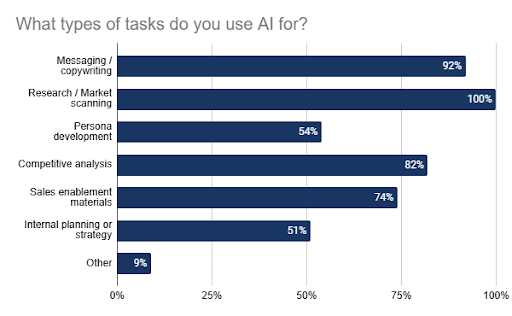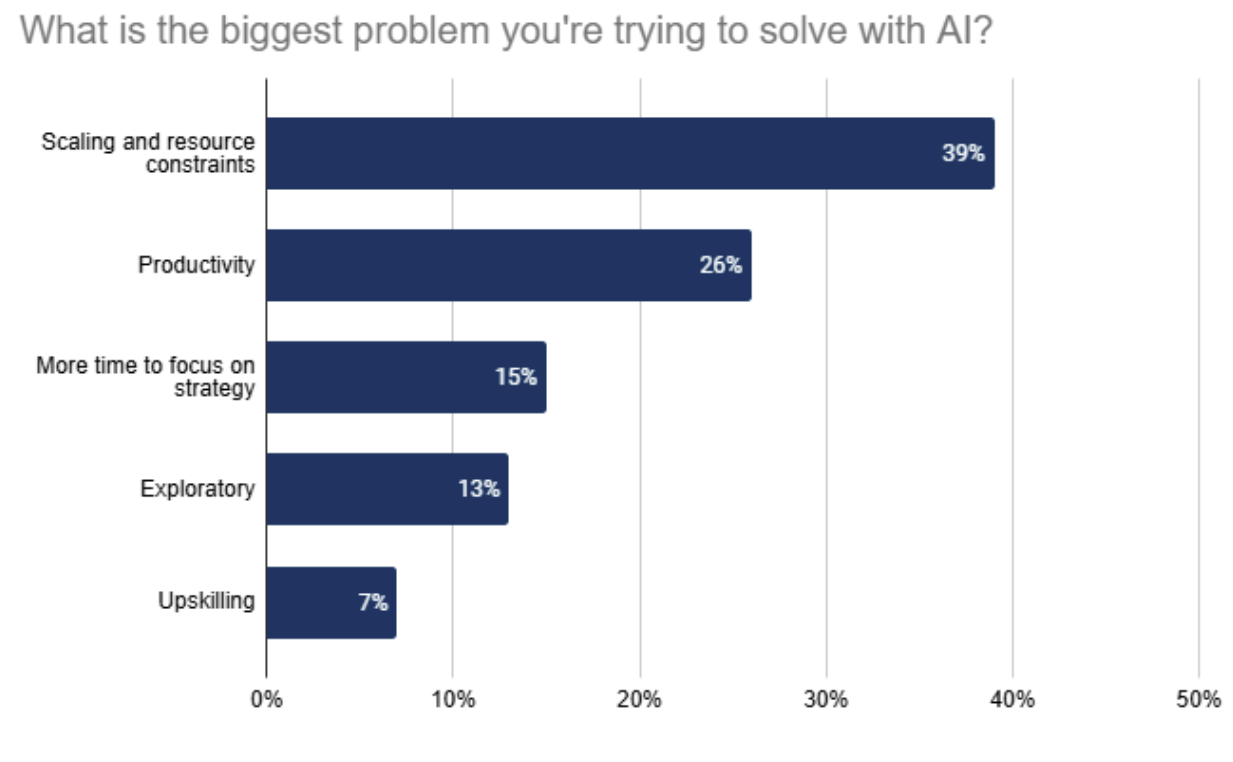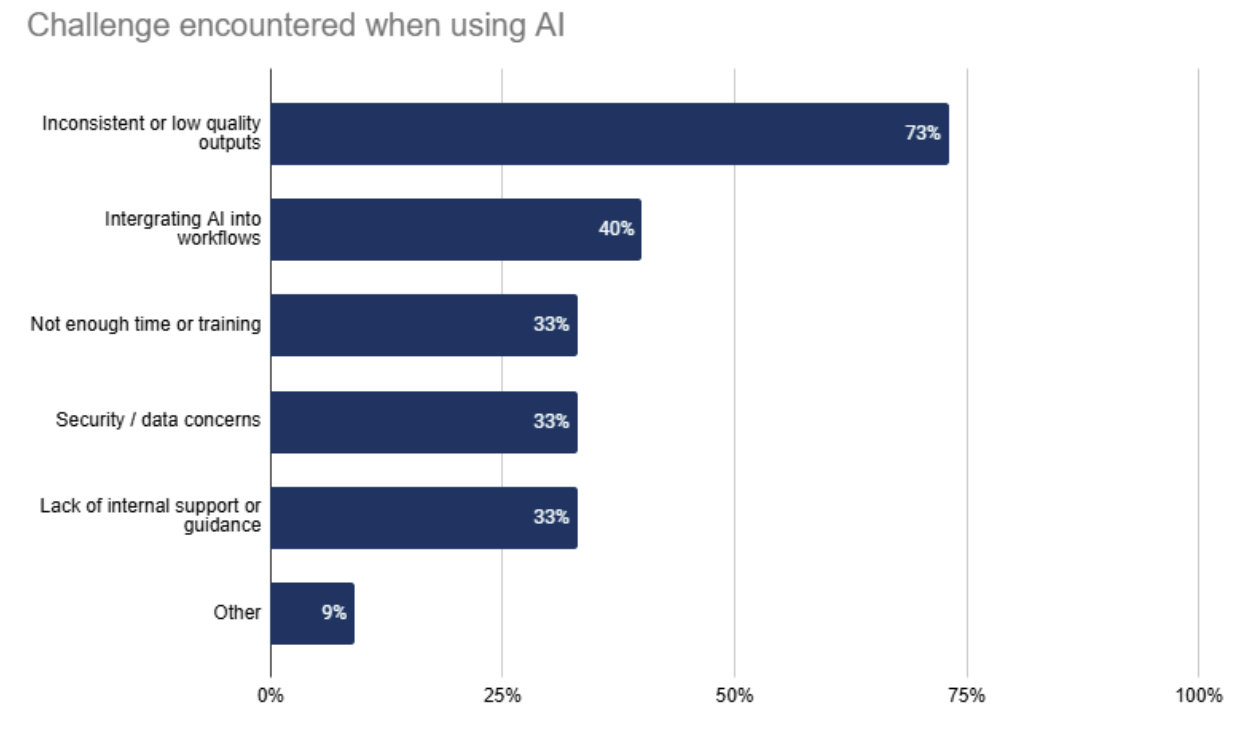2025 Product Marketing AI Trends Report: Why Adoption Is Rising—But Strategy Still Lags
Fluvio Research led by Lyle Burns
Artificial Intelligence (AI) is fundamentally reshaping the role of product marketing. Amid rising expectations and reduced team sizes, product marketing teams are increasingly turning to AI to enhance productivity, creativity, and strategic impact. Fluvio embarked on this research to uncover how product marketing teams are currently using AI, what challenges they face, and what best practices can help guide future adoption.
Executive Summary
Product marketing teams are under pressure. Headcount is shrinking. Expectations are growing. And AI is no longer a novelty, it's a necessity.
We interviewed and surveyed 40 product marketing leaders across a diverse set of companies. The data reveals a discipline in flux:
88% expect their use of AI to increase.
75% report moderate adoption, but only 15% have it deeply embedded.
93% are using AI to improve productivity.
But here’s the tension: AI use is growing fast, yet governance, training, and clear strategy often lag behind. For many, AI is still an individual sport that’s driven by motivated PMMs, yet unsupported by systems.
At larger companies (1,001+ employees), AI is more likely to be embedded and governed. Smaller orgs are often scrappier: tactical, tool-driven, and less structured.
The big unlock? Ownership and enablement. Teams with centralized AI strategy are 2.6x more likely to track measurable outcomes. This isn’t about experimenting with tools like ChatGPT or Claude. It's about scaling AI fluency across the team.
This report breaks down what’s working, what’s missing, and how forward-thinking teams are installing AI as a true competitive advantage.
Methodology and Respondent Profile
Data was collected via interviews and a survey answered by 40 professionals in product marketing roles across various organization sizes:
8% from organizations with 5,000+ employees
17% from organizations with 1,001 - 5000 employees
35% from organizations with 201 - 1000 employees
25% from companies with 51 - 200 employees
15% from companies with <50 employees
Respondent Role Breakdown
52% were Directors,VPs of Product Marketing, or CMOs
28% were Senior Product Marketing Managers
20% were Product Marketing Managers
Respondents were asked about AI tools, workflows, governance, challenges, and aspirations.
Learnings and Insights
AI is now central to the product marketing toolkit, but usage varies widely. Most teams report moderate maturity (74%), and 87% expect to ramp up usage in the future. Still, only 15% say AI is deeply embedded.
AI adoption is driven by leaner teams and rising demands. In the open-ended responses, 38% of product marketers cited resource constraints as the biggest driver behind AI adoption—making it the most common theme. The goal? Scale output without scaling headcount. And it's working: 92% say AI helps them create content faster, while 92% also report improved productivity. Looking ahead, 87% expect usage to keep climbing.
Still, gaps in governance and strategy persist. Just 28% provide training, and 59% report having a responsible use or governance policy. Strategy is decentralized for many. 28% of respondents said their team decides independently, and 20% said no one owns it yet. Larger orgs show more structure, with embedded workflows and measurable outcomes. In fact, centralized ownership makes teams 2.6x more likely to track impact.
The takeaway? Individual usage is high. Maturity requires infrastructure, not just enthusiasm.
1. The Tipping Point: From Curiosity to Capability
““I’m using AI to do more with less; I’m the only PMM so I need to get a lot accomplished every week.” ”
““We’re using AI to free up time to focus on strategy and competitive intelligence which will help close deals.” ”
Current State of Usage: A Fragmented Landscape
AI adoption across product marketing teams is widespread, but not yet unified. Market research/scanning (100%), messaging and copywriting (92%), and competitive analysis (82%) are the top use cases reported by respondents.
““Some people in our organization are shy about using AI and don’t understand how to use it effectively. Others are purists, they just don’t want to use it.” ”
Tools like ChatGPT dominate for copywriting, while embedded systems like Microsoft Copilot are being used more for day-to-day productivity support, especially in large enterprises. In our data, Copilot usage appears exclusively among organizations with 5,001+ employees, underscoring how embedded AI tools, especially those built into enterprise platforms like Microsoft 365, play a more prominent role at scale.
Most teams (74%) describe their AI maturity as moderate, and only 15% report it as deeply embedded. A clear divide exists by org size: larger companies are more likely to integrate AI into core workflows, whereas smaller teams often use it in more isolated, ad hoc ways.
Motivation: Doing More With Less
For many PMMs, AI isn’t just a boost, it’s a support structure. In a climate where team sizes aren’t keeping pace with expectations, AI is emerging as a tactical solution to systemic constraints. 38% of respondents cited resource gaps and scaling challenges as their primary motivator for adopting AI. But this isn't just about doing the same work faster, it’s about keeping up with fewer hands. AI is helping teams shoulder executional load, unlock bandwidth, and maintain output quality amid flat or shrinking budgets. AI has become a core lever for sustaining performance under pressure as 92% of PMMs cite productivity gains from AI.
In fact, in our recent 2025 Product Marketing Hiring Trends Report, we found that PMM candidates “encountered perspectives that reduced PMM to tactical execution” and companies often post PMM leadership roles, but aren’t prepared to provide the necessary team support and buy-in to enable leaders to succeed. The absence of strategic hires forces ICs and stretched leaders to rely on AI to fill operational and executional gaps. AI isn't replacing roles, it’s plugging holes in a broken structure. Expecting quality of output to maintain and PMMs to drive strategy solely through the reliance of AI support may prove to be unsustainable or even impractical.
““With headcount limits coming, there’ll be an org-wide push to use AI more and we’ll likely lead that.” ”
““We’ve found that AI enables us to increase our output and multiply our impact. Tasks that used to take weeks now take days. Tasks that took hours now take minutes.” ”
Roadblocks to Maturity
Teams face significant friction as they scale AI adoption. The most common challenges cited include content quality concerns, lack of guidance or enablement, data privacy risks, and unclear leadership around AI use. These gaps slow down momentum, particularly for teams trying to use AI for more strategic tasks. At the same time, teams are turning to AI to solve real problems, chiefly boosting team capacity and accelerating content delivery. But without the right support systems, those ambitions can outpace what AI alone can deliver.
““A big challenge is balancing internal AI integrations versus using vendor platforms that are already building AI in. We don’t want to reinvent the wheel but also want alignment.””
““My biggest challenge with AI right now is getting teams comfortable with using it.” ”
Missing Foundations: Governance and Strategy
Governance and strategy are often the missing pieces in AI adoption. Only 28% of teams offer training, and 59% report having a responsible use or governance policy. 28% of respondents said their team decides independently, while another 20% noted that no one owns it yet.
““We hold internal enablement sessions instead of using prompt libraries. Models evolve too fast; static prompts get stale.” ”
Structure pays off. Every team reporting frequent AI usage or measurable outcomes also reported some level of governance.
Even lightweight policies can drive adoption. And centralized ownership boosts the likelihood of tracking impact by 2.6x.
““We’ve got a formal AI council internally that sets the guardrails with training, approved tools, and best practices. It’s helped build confidence and consistency.””
Looking at this report and our recent hiring report, we find that whether it’s scaling AI or building high-performing teams, structure is the difference between experimentation and impact. Leadership plays a pivotal role: it drives enablement, governance, and maturity. Without it, teams remain stuck in ad hoc execution. With it, they turn tools into strategy.
““You only know what you know - I’d like exposure and training on how others are using it so that we can evaluate using it too. I seem to only know what I discover myself.””
2. The Divide: How Org Size and Seniority Shape AI Adoption
AI maturity varies significantly by company size.
Mid-size orgs (201-1,000 employees) are the most represented in the survey and commonly report moderate AI adoption. While 100% of these teams have some form of governance, their structure remains inconsistent. Directors and PMMs in these organizations use AI regularly, but few teams have moved beyond weekly, tactical applications.
Smaller companies (<200 employees) tend to operate more independently, often using AI in fragmented, ad hoc ways without formal governance. Usage is largely exploratory and driven by individuals rather than unified strategy—highlighting the need for structure as these teams scale.
Enterprises (1,001+ employees) show the highest AI maturity. Most respondents from this group report some form of governance, and AI usage is frequent, often daily, among Lead and Senior PMMs. These organizations are more likely to track outcomes and assign cross-functional ownership, aligning with stronger enablement practices.
Directors and VPs report higher AI usage than independent contributors, and are the primary advocates for strategic use of AI. Their involvement often drives the push for centralized ownership and measurable impact.
Looking ahead, respondents expressed a desire to use AI beyond tactical execution. This includes tasks such as identifying customer pain points and insights, GTM planning, and persona development. These aspirations point to a shift from tool-driven experimentation to strategy-enabling systems.
3. What’s Next: Future-Readiness and Forecasts
As teams mature in their AI usage, they’re beginning to anticipate a shift in AI’s role from executional tool to strategic driver. Product marketers are forecasting a future where AI contributes not just to messaging and copy, but also to positioning, GTM strategy, and planning. Prompt fluency is on track to become a required skill, much like writing a brief or building a campaign framework.
““AI has totally changed our RFP process… It’s helped us close deals faster and raised conversion rates. Product marketing is now seen as a revenue driver, not just support.” ”
Governance, too, is evolving. The need for lightweight but structured enablement is growing, particularly in larger orgs where tool adoption outpaces policy. And AI is increasingly being seen as part of team capacity modeling—a resource multiplier embedded into how PMMs plan, work, and scale.
““Going forward AI can empower every marketer with 2 interns” ”
Desires for AI
As teams mature in their AI usage, they’re beginning to anticipate a shift in its role, from a tactical assistant to a strategic enabler. Product marketers increasingly view AI as a supplement to strategic work, not a replacement. They expect AI to support positioning, GTM strategy, and planning in ways that enhance human decision-making without removing oversight. Prompt fluency is on track to become a required skill, much like writing a brief or building a campaign framework.
““I would like AI to replace content and competitive requests—the two largest time burdens on my team. In the time it takes to Slack PMM a competitive question or ask for an asset, GenAI can source that information or create a version of that asset.””
““I want to get a better understanding of how I can use it to my advantage—but not in a way that can automate all my work and replace me. I want it to make me a better PMM and not a replaceable one.” ”
AI expectations are evolving. Product marketers now want more than just efficiency. Teams are looking to AI for strategic insight and competitive edge.
What’s fueling this shift?
Growing hope in AI’s capabilities: Teams are gaining experience with AI tools and seeing tangible results, opening them up to exploring higher-value use cases.
Increasing pressure to perform with fewer resources: As headcount shrinks and expectations rise, PMMs are being asked to do more with less—prompting them to lean on AI not just for execution, but for scaling strategic thinking.
Concerns for the Future
While excitement about AI’s potential is high, concerns exist. Product marketers that are using AI frequently identify the following challenges: inconsistent or low-quality outputs (72%), difficulty integrating AI into workflow (41%), lack of time or training (33%), and security or data concerns (31%).
These signal a need for better enablement, clearer policies, and workflow-level integration. These are not just implementation risks, they’re cultural and strategic risks as well.
““Moving forward, AI should be used to ensure humans are focusing on higher value work… The biggest challenge right now, is that a lot of AI produces good content, but not great. So, unless you are already a good writer, for example, you wouldn’t necessarily know when AI is giving you something subpar.” ”
““You need a next-level read on AI-generated content. It can sound generic or gloss over key points.” ”
““Trusting AI insights is hard without clean data. You need to know what good output looks like or you’ll get garbage in, garbage out” ”
““We don’t want to over-rely on AI and lose the unique tone of our brand. That’s something we’re constantly watching.” ”
Recommendations
To move from experimentation to strategic advantage, product marketing leaders must treat AI as a critical capability, not an accessory
It’s time to stop treating AI as a siloed toolset and start embedding it as a team-wide capability. So, here’s a flexible playbook and plan of action for each level of organizational maturity and role:
For Executive Leadership (CMO, VP of Product Marketing)
Centralize AI Strategy and Ownership: Assign cross-functional ownership of AI and make it part of the org-wide marketing roadmap.
Build a Scalable AI Framework: Define policies, toolkits, and governance templates. Standardize workflows and documentation.
Measure ROI and Outcomes: Implement tracking for productivity, asset velocity, and impact on GTM speed and quality.
For Team Leads and Directors
Operationalize Governance and Enablement: Codify best practices, facilitate internal training, and ensure prompt hygiene. Rather than building rigid prompt libraries, which may age quickly, focus on repeatable prompts, scenario-based examples, and shared prompting techniques that work across tools. Create team-specific onboarding to ensure consistency and confidence.
Drive Strategic AI Use Cases: Go beyond content and experiment with AI for planning, positioning, competitive analysis, and campaign design.
For Individual Contributors (PMMs, Leads)
Adopt AI as a Daily Copilot: Use AI for brainstorming, drafts, outlines, summaries, and creative refinement. Share successful prompts and workflows internally.
For All Teams
Build Toward Scalable AI Maturity: Use a phased approach, starting with exploration, then standardization, followed by enablement, measurement, and iteration. Focus first on foundational policies and training. Then layer in shared playbooks, internal champions, and routine outcome reviews to embed AI across functions.
Coordinate Governance at the Org and IT Level: AI maturity isn't just a team-level initiative. It's a cross-functional priority. Push IT, legal, and procurement to implement processes for secure integrations, compliance alignment, thoughtful vendor management, and data security. As data flows through AI tools, protecting customer and company information must be foundational. Build governance that scales with adoption and supports innovation across the organization.
This report is a snapshot of product marketing in transformation. AI is reshaping how work gets done. Today, most teams are stuck between early momentum and lasting maturity.
The standout insight? Structure matters. Teams with ownership, enablement, and measurement in place are seeing real ROI. Those without are still relying on individual effort.
The next era of product marketing belongs to the teams who operationalize AI. Who invest in governance. Who treat prompt fluency like a core competency.
Whether you're a VP leading change or a PMM building smarter workflows, one thing is clear: the moment to act is now.
AI isn't the future of product marketing. It's the present. Let's build accordingly.









